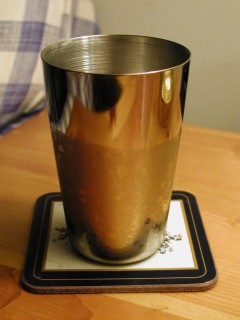Prioritize...
By the end of this section, you should be able to discuss why the idea that warm air holds more water vapor than cold air is a fallacy, and discuss how water drops grow in terms of condensation rates and evaporation rates.
Read...
Have you ever been taught that "warm air holds more water vapor than cold air," or perhaps heard it when reading or watching a story about weather? If you search around on the Web, you can find plenty of sites that explain processes like cloud formation with the idea that cold air can't hold as much water vapor as warm air. The explanations usually go something like this: "air cools to the point where it can't hold any more water vapor, and liquid water drops form." But, don't believe everything you read on the Internet! This idea is scientific garbage, and it poorly describes what's really happening when net condensation causes liquid water droplets to form.
Motivating Myth: Warm air holds more water vapor than cold air. Or alternatively, cold air can hold less water vapor than warm air.

For starters, let's examine what accepting this myth really implies. By accepting this myth, we're basically treating air like a sponge, and once all the pores in the sponge get filled with water, it can't absorb any more water, so water starts dripping from the saturated sponge. But, air isn't like a sponge. Air is also not like a hotel, which posts a "No Vacancy" sign when all of its rooms are filled with water vapor. If these ideas sound a little silly, it's because they are!
What we call "air" is really mostly empty space with tiny molecules flying around independently of each other. If we had a box filled with air, the "air" molecules (oxygen, nitrogen, carbon dioxide, etc.) would occupy a really tiny fraction of the space in the box, regardless of the temperature. In other words, no matter what the temperature is, there's always enough room for more water vapor molecules. So, the idea that colder air doesn't have enough room to hold more water vapor molecules is nonsense!
So, why is the myth that "warm air holds more water vapor than cold air" so common? Well, it's an "easy" explanation, and sometimes folks (even those who should know better) take unfortunate shortcuts. This particular myth seems to explain the observation that net condensation (and the formation of liquid water drops) more easily occurs at lower temperatures. But, what's really going on? Let's explore.
From the recent discussion of condensation rates and evaporation rates, you already know what's going on when liquid water drops form and grow -- net condensation is occurring because the condensation rate is greater than the evaporation rate. But, at higher temperatures, evaporation rates increase, and with increased evaporation rates, even higher condensation rates are required for net condensation to occur. As you know, higher condensation rates occur when the number of water vapor molecules increases, so when the air is warm, the high evaporation rates give the potential for a higher number of water molecules to remain in the vapor state without net condensation occurring. In other words, when it's warm, more water vapor molecules are needed in order for liquid water drops to form and grow. When the air is cooler, evaporation rates are decreased, meaning that fewer water vapor molecules are required for net condensation to occur.

We can use these ideas to analyze what's going on in the photograph on the left, which shows something that you've probably observed before -- liquid water drops forming on the outside of a glass containing a cold beverage. This photograph shows a metal cup partially filled with cold water. The bottom half of the cup (approximately) is coated with a layer of small liquid water drops (often called “dew”), while the top half is not. So, should we believe that somehow the air near the bottom half of the cup can't "hold" any more water vapor, which caused liquid water droplets to form on the side of the glass, while the air just above can magically "hold" more water vapor (since no water drops had formed on the top part of the cup)? Absolutely not!
Remember, evaporation and condensation are occurring around you all the time, even if you can't see the results. Therefore, water molecules are impacting (condensing) and leaving (evaporating) all over the surface of the cup, but the rates of evaporation differ from the bottom half of the cup to the top half. Recall that the cup is partially filled with cold water, which has made the bottom part of the cup relatively cold, and in turn, a thin layer of air surrounding the bottom half of the cup cools as well.
Near the cold bottom half of the cup, water vapor molecules move more slowly and the rate of evaporation is reduced. When the air in contact with the cup cools enough so that the rate of evaporation is slightly less than the rate of condensation (net condensation occurs), liquid water drops form and grow. Meanwhile, the top-half of the cup, and the thin layer of air immediately surrounding it, are warmer, leading to a higher rate of evaporation, and the rate of evaporation is greater than the rate of condensation. In other words, any microscopic water droplets that temporarily form on the top half of the cup evaporate almost immediately (because net evaporation is occurring), causing the outside of the top-half of the cup to remain dry.
So, cooling the air (decreasing its temperature) is one way to achieve net condensation. If the air cools enough (temperature decreases enough) that the evaporation rate becomes less than the condensation rate, net condensation can occur, and liquid water drops can form and grow. Another way to achieve net condensation is to increase the amount of water vapor molecules present (increase the dew point), which leads to a greater rate of condensation. If the amount of water vapor molecules increases enough (dew points increase enough) to make the condensation rate greater than the evaporation rate, then net condensation can occur, and liquid water drops can form and grow.
However, in the atmosphere, the most common way for net condensation to occur (especially for processes like cloud formation) is to cool the air. For example, in theory, clouds form when the air cools and the temperature drops to, and ever so slightly below, the dew point. Observations show that the relative humidity inside clouds is usually slightly greater than 100 percent (say, 100.2 percent as a representative value), which means the condensation rate slightly exceeds the evaporation rate. In a cloud that forms from rapidly rising air, the rate of condensation exceeds the rate of evaporation because the rate of cooling is faster than the rate that water vapor is being removed from the air via condensation. In other words, the evaporation rate decreases more quickly than the condensation rate (which declines as liquid water drops grow, and fewer water molecules are in the vapor phase), causing the condensation rate to exceed the evaporation rate (and resulting in a relative humidity slightly higher than 100 percent).
The bottom line is that the growth of liquid water droplets as "dew" on the side of your drinking cup, on blades of grass in the morning, or as cloud droplets (just as a few examples), depends on evaporation rates and condensation rates. Liquid water drops grow when net condensation occurs, and not because the air just can't "hold" any more water vapor. Remember, there's always plenty of room in cold air for water vapor molecules.
The real issue is that as the temperature of the air decreases, water vapor molecules slow down and evaporation rates decrease, making it possible for condensation rates to exceed evaporation rates (if enough cooling occurs). But, in order to achieve net condensation in the real atmosphere, we need another ingredient. We'll explore that on the next page, as well as discuss the overall recipe for making clouds.